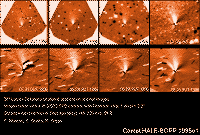G.A.T. - Gruppo Astrofili Tradatese
in collaborazione con laS.A.S. - Stazione Astronomica di Sozzago
Astro-link è lieta di ospitare ed promuovere la diffusione del materiale del G.A.T.. Si tratta di un archivio di immagini cometarie di valore scientifico di cui di seguito è possibile vedere solo una minima parte.
 |
 |
 |
L'archivio completo:
gat.zip è di circa 320 kb.
Si auspica la massima diffusione del materiale.
Segue il testo originale così come inviato dagli autori F.Manzini, R.Crippa e C.Guaita.
Sunward jets from Comet Hale-Bopp
Images of Comet Hale-Bopp were taken with 33,5 cm reflector of SAS Observatory (near Milano, Italy), equipped by a CCD camera ( chip Thomson 7895 M) without any filter.We applied Larson-Sekanina algoritm to elaborate some sets of CCD pictures taken on May 28.00 U.T. (cumulative exposition of 300 seconds), on July 25.00 U.T., on July 30.9 U.T. and July 31.9 U.T. (cumulative exposition of 600 seconds)
Together with a well defined antisolar tail more than 6' long, it was surprising to observe almost three principal linear jets (at p.a.=40¡, 145¡ and 270¡) and two other secondary jets coming from the nuclear region toward solar direction too. The angolar position of the jets seems costant during last week of July. Images taken on August 16, show a great increase in the number and complexity of sunward jets, but olso a clear modification of the tail ( that now appears as dubble) (see very well the last images inclosed).
On May 28 the jets were very faint. Now, at the end of July, luminosity of tail and of linear jets don't appear very different. The jets are linear up to 60Ó- 80" from the nucleus and don't show any tendency to bend in fountain shape. This is quite surprising if compared with a large number of fountain jets we observed from Hyalutake nuclear region on March and April '96, by the same equipment and after the same kind of elaboration.
We interpret the difference between Hyakutake and Hale-Bopp jets as linked to the different distance from the Sun. Probably, Hale-Bopp is now so far from the sun ( 3.6 A.U.) that solar wind is not able to bend its jets toward antisolar direction. Anyhow, the discovery of so bright jets is an other clear indication that Hale-Bopp is an intrinsecally bright comet. Our Group is part of a Consortium between italian Institutes, created by Prof. C.B.Cosmovici, to coordiante studies about SL9, Hyakutake and Hale-Bopp comets.
We would appreciate very much any comments, suggestions and information about some other similar observation.
Enclosed you can find some Hale-Bopp elaborated pictures and a Hyakutake picture taken on March 28 (we elaborated on the some way).
Torna alle pagine dello Speciale Hale-bopp.
Vai all'indice delle Iniziative.
Vai alla HomePage di Astro-link.